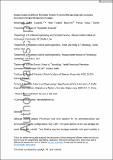| dc.contributor.author | Tavakoli, Mohammad Mahdi | |
| dc.contributor.author | Dastjerdi, Hadi Tavakoli | |
| dc.contributor.author | Yadav, Pankaj | |
| dc.contributor.author | Prochowicz, Daniel | |
| dc.contributor.author | Si, Huayan | |
| dc.contributor.author | Tavakoli, Rouhollah | |
| dc.date.accessioned | 2022-02-11T18:38:29Z | |
| dc.date.available | 2022-02-11T18:38:29Z | |
| dc.date.issued | 2021-03-18 | |
| dc.identifier.issn | 1616-301X | |
| dc.identifier.issn | 1616-3028 | |
| dc.identifier.uri | https://hdl.handle.net/1721.1/140297 | |
| dc.description.abstract | Here, highly efficient and stable monolithic (2-terminal (2T)) perovskite/PbS quantum dots (QDs) tandem solar cells are reported, where the perovskite solar cell (PSC) acts as the front cell and the PbS QDs device with a narrow bandgap acts as the back cell. Specifically, ZnO nanowires (NWs) passivated by SnO2 are employed as an electron transporting layer for PSC front cell, leading to a single cell PSC with maximum power conversion efficiency (PCE) of 22.15%, which is the most efficient NWs-based PSCs in the literature. By surface passivation of PbS QDs by CdCl2, QD devices with an improved open-circuit voltage and a PCE of 8.46% (bandgap of QDs: 0.92 eV) are achieved. After proper optimization, 2T and 4T tandem devices with stabilized PCEs of 17.1% and 21.1% are achieved, respectively, where the 2T tandem device shows the highest efficiency reported in the literature for this design. Interestingly, the 2T tandem cell shows excellent operational stability over 500 h under continuous illumination with only 6% PCE loss. More importantly, this device without any packaging depicts impressive ambient stability (almost no change) after 70 days in an environment with controlled 65% relative humidity, thanks to the superior air stability of the PbS QDs. | en_US |
| dc.language | en | |
| dc.publisher | Wiley | en_US |
| dc.relation.isversionof | http://dx.doi.org/10.1002/adfm.202010623 | en_US |
| dc.rights | Article is made available in accordance with the publisher's policy and may be subject to US copyright law. Please refer to the publisher's site for terms of use. | en_US |
| dc.source | Wiley | en_US |
| dc.title | Ambient Stable and Efficient Monolithic Tandem Perovskite/PbS Quantum Dots Solar Cells via Surface Passivation and Light Management Strategies | en_US |
| dc.type | Article | en_US |
| dc.identifier.citation | Tavakoli, M. M., Dastjerdi, H. T., Yadav, P., Prochowicz, D., Si, H., Tavakoli, R., Ambient Stable and Efficient Monolithic Tandem Perovskite/PbS Quantum Dots Solar Cells via Surface Passivation and Light Management Strategies. Adv. Funct. Mater. 2021, 31, 2010623. | en_US |
| dc.contributor.department | Massachusetts Institute of Technology. Department of Electrical Engineering and Computer Science | |
| dc.contributor.department | Massachusetts Institute of Technology. Department of Materials Science and Engineering | |
| dc.relation.journal | Advanced Functional Materials | en_US |
| dc.eprint.version | Author's final manuscript | en_US |
| dc.type.uri | http://purl.org/eprint/type/JournalArticle | en_US |
| eprint.status | http://purl.org/eprint/status/PeerReviewed | en_US |
| dspace.date.submission | 2022-02-09T19:48:40Z | |
| mit.journal.volume | 31 | en_US |
| mit.journal.issue | 21 | en_US |
| mit.license | PUBLISHER_POLICY | |
| mit.metadata.status | Authority Work Needed | en_US |
